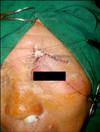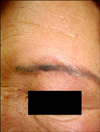Abstract
Malignant skin tumors, including squamous cell carcinoma and malignant melanoma, have occurred in tattoos. Seven documented cases of basal cell carcinoma associated with tattoos have also been reported in the medical literature. We encountered a patient with basal cell carcinoma in a tattooed eyebrow. We report on this case as the eighth reported case of a patient with basal cell carcinoma arising in a tattooed area.
Tattoos have been used in many countries for cosmetic purposes throughout the centuries. As the concern for beauty is increasing, cosmetic facial tattooing with permanent makeup such as eyeliner, an eyebrow tattoo and lip lining has become popular among women. Although tattoos are common, popular and usually well tolerated, cutaneous complications can occur. Several benign and malignant lesions may occur in tattoos, including verruca, granulomas, keratoacanthomas, squamous cell carcinomas, malignant melanomas and basal cell carcinomas1,2. With the expanding popularity of cosmetic tattoos, dermatologists can expect to observe a vast array of tattoo-associated cutaneous complications, including basal cell carcinoma. To date, there have been only seven patients in the medical literature with basal cell carcinoma that occurred within tattoos3-7. We encountered a 60-year-old Korean woman who presented with a depressed sclerotic patch within an eyebrow tattoo, and this lesion had the histological features of basal cell carcinoma.
A 60-year-old Korean woman presented with a 2-year history of a pruritic depressive patch on her left eyebrow. She was tattooed on her left eyebrow for cosmetic purposes about 5 years previously. Three years later, a pinhead-sized papule developed within the tattooed area and the lesion slowly increased in size.
The physical examination revealed a 1.1×1.3 cm, annular, skin-colored, depressed sclerotic patch with a hard translucent papule and a peripheral erythematous rim in a black tattoo on her left eyebrow (Fig. 1). There was no personal or family history of malignant skin tumors. There was no cervical lymphadenopathy. The results of the routine laboratory studies were normal or negative, including the urine analysis, a complete blood count, a differential leukocyte count, the erythrocyte sedimentation rate and the blood chemistry studies. Chest x-ray examination, facial bone and neck computed tomography and a whole body bone scan revealed no abnormalities or metastasis. The histopathologic findings show basal cell carcinoma of various shapes and sizes, and these lesions consisted of basaloid cells in a dense fibrous stroma and black tattoo pigment. The tumor masses show a limited peripheral palisading arrangement of nuclei and peritumoral lacunae (Fig. 2).
The patient was treated with Mohs micrographic surgery and a Burow's graft with using adjacent tissue (Fig. 3). Eyebrow pencil was applied over the eyebrow to conceal the hair loss in the graft area (Fig. 4). There has been no evidence of recurrence or metastasis on the follow-up examinations for 2 years.
Tattooing has been practiced worldwide for cosmetic and therapeutic purposes for over 4,000 years. Cosmetic tattoos are used for permanent makeup, such as eyeliner, lip liner, lipstick brush and eyebrows, and cosmetic tattoos have many other practical applications. Tattoos might be a solution for individuals who have scars, birthmarks, alopecia, vitiligo, allergies to conventional cosmetics or difficulties applying cosmetic makeup due to visual impairment or arthrodesis. Cosmetic tattooing of women has increased in spite of the sharp traumatic injury and the introduction of potentially toxic materials into the skin during the procedure. Cosmetic tattooing that includes tattooing eyebrows and that's performed by amateurs in Korean beauty salons is fairly fashionable, but it is still considered an illegal activity that violates Korean medical laws.
Numerous medical complications may result from tattoos, and these complications are primarily infectious and inflammatory in nature. Among these complications are superficial infections, deep skin infections, tetanus, chancroid, syphilis, viral infection (verruca, molluscum, hepatitis, AIDS), mycoses, granulomas, allergic disorders and localized skin disorders such as psoriasis, lichen planus and lupus erythematosus2. Several malignant lesions, although extremely rare, have also occurred in tattoos. To the best of our knowledge, 11 cases of malignant melanomas8, 7 cases of basal cell carcinomas (Table 1)3-7, 3 cases of squamous cell carcinomas9,10 and 1 case of reticulohistiocytoma11 developing within tattoos have currently been reported in the English medical literature. Our patient is the eighth case of basal cell carcinoma arising in a tattooed area and it is the first case of a malignant tumor within tattoos at the eyebrow region.
The pathogenesis of malignant skin tumors in tattoos is still unknown. A review of the literature revealed that a few basal cell carcinomas developed in tattoos located on sun-protected areas, which suggests that other factors such as trauma are associated with the occurrence of basal cell carcinoma. Indeed, many cases of developing basal cell carcinoma have been related to various traumas, including tattoos, thermal burn scars, vaccination sites, chicken pox scars, blunt or sharp injury, exposure to polycyclic aromatic hydrocarbons, scars of lupus vulgaris, chronic stasis ulcers, frostbite, hair transplantation, lesions of epidermolysis bullosa, colostomy, gunshot wound, sternostomy and vasectomy12. The mechanism of trauma related to carcinogenesis is not well established, but the mechanism has been hypothesized to involve an increased sensitivity to sunlight due to poor vascularity and elasticity in the damaged tissue13, a localized nutritional deficiency in a traumatic scar12, chronic irritation14, chronic release of toxins that can lead to the mutation of cells15 or implantation of epidermal cells into the subcutis with disruption of the normal defense system16. Moreover, one author has postulated that the dark color of tattoos may indirectly induce carcinogenesis by altering the absorption of ultraviolet rays because most of the basal cell carcinomas that have arose in tattoos have tended to develop within the dark color of tattoos5. But it is difficult to deduce whether tattoos act as a primary carcinogen or as a co-carcinogen together with sunlight or trauma. However, on considering the number of individuals tattooed around the world and the extreme rarity of basal cell carcinoma that has developed in tattoos, it may just be a chance finding. Our patient had been exposed to ultraviolet irradiation for many years so that chronic exposure to sunlight can reasonably be considered the main factor for the development of her basal cell carcinoma. However, the eyebrow region, similar to the preauricular area, the jaw and the chin, is a relatively less exposed site of the face and it receives less than 20% of the maximum ultraviolet exposure17. Hence, we conclude that other stimuli, such as trauma or an irritative agent from the tattoo, may have acted as an additional cofactor in the pathogenesis of the patient's basal cell carcinoma. Further studies are necessary to determine the causal relationship of trauma and tattoo for the induction of malignant tumors.
The dark color of tattoos can make it difficult to detect pigmented skin lesions, including malignant tumors. Therefore, careful attention and follow-up care should be given to the pigmented lesions within tattoos.
Figures and Tables
Fig. 1
A 1.1×1.3 cm, skin-colored, sclerotic, depressed patch with a translucent papule and a peripheral erythematous rim within the black tattoo pigment on the left eyebrow.

Fig. 2
The histopathological features show tumor masses of various shapes and sizes and the masses consist of basaloid cells and black tattoo pigment. The tumor masses show a limited peripheral palisading arrangement of the nuclei and peritumoral lacunae (H&E, ×100).

References
2. Kazandjieva J, Tsankov N. Tattoos: dermatological complications. Clin Dermatol. 2007. 25:375–382.

3. Bashir AH. Basal cell carcinoma in tattoos: report of two cases. Br J Plast Surg. 1976. 29:288–290.

4. Earley MJ. Basal cell carcinoma arising in tattoos: a clinical report of two cases. Br J Plast Surg. 1983. 36:258–259.

5. Wiener DA, Scher RK. Basal cell carcinoma arising in a tattoo. Cutis. 1987. 39:125–126.
6. Doumat F, Kaise W, Barbaud A, Schmutz JL. Basal cell carcinoma in a tattoo. Dermatology. 2004. 208:181–182.

7. Birnie AJ, Kulkarni K, Varma S. Basal cell carcinoma arising in a tattoo. Clin Exp Dermatol. 2006. 31:820–821.

8. Paradisi A, Capizzi R, De Simone C, Fossati B, Proietti I, Amerio PL. Malignant melanoma in a tattoo: case report and review of the literature. Melanoma Res. 2006. 16:375–376.

9. McQuarrie DG. Squamous-cell carcinoma arising in a tattoo. Minn Med. 1966. 49:799–801.
10. Pitarch G, Martinez-Menchon T, Martinez-Aparicio A, Sanchez-Carazo JL, Munoz D, Fortea JM. Squamous cell carcinoma over tattoos. J Am Acad Dermatol. 2007. 56:1072–1073.

11. Beerman H, Lane RA. Tattoo; a survey of some of the literature concerning the medical complications of tattooing. Am J Med Sci. 1954. 227:444–464.
12. Noodleman FR, Pollack SV. Trauma as a possible etiologic factor in basal cell carcinoma. J Dermatol Surg Oncol. 1986. 12:841–846.

13. Connolly JG. Basal cell carcinoma occurring in burn scars. Can Med Assoc J. 1960. 83:1433–1434.
14. Hill BB, Sloan DA, Lee EY, McGrath PC, Kenady DE. Marjolin's ulcer of the foot caused by nonburn trauma. South Med J. 1996. 89:707–710.

15. Fleming MD, Hunt JL, Purdue GF, Sandstad J. Marjolin's ulcer: a review and reevaluation of a difficult problem. J Burn Care Rehabil. 1990. 11:460–469.
16. Neuman Z, Ben-Hur N, Shulman J. Trauma and skin cancer. Implantation of epidermal elements and possible cause. Plast Reconstr Surg. 1963. 32:649–656.




 PDF
PDF ePub
ePub Citation
Citation Print
Print






 XML Download
XML Download